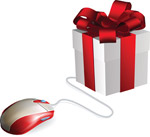
The holiday season may be the most wonderful time of the year for consumers, but for the merchants that do the bulk of their business in the fourth quarter, it can be pretty stressful.
Did we select the right products? Did we buy enough merchandise? Are we targeting the right lists? Do we have enough creative promotions? Is our website ready? Can our operations handle the peak workload?
Some factors you can’t do much about at this point, but there are many strategies and tips you can still implement now. Don’t be afraid to test some tactics to drive sales this season.
“Holiday may not be the best time to experiment, but it’s a great time to learn,” says Jason Goldberg, vice president of strategy and customer experience of Crossview, a cross-channel retail systems provider. “Your continuous improvement and reaction cycles need to be much shorter during the holidays, as one day in your holiday season may be the equivalent of two to three weeks during your off-peak,” he notes.
With that in mind, here are 27 tips to help make your season a merry one. — plus, read our 10 bonus tips to drive inbound links.
Jump To:
Ecommerce: Tips 1-7
Email: Tips 8-10
Marketing: Tips 11-14
Social Media: Tips 15-18
Search/PPC: Tips 19-21
Mobile: Tips 22-24
Operations: Tips 25-27
ECOMMERCE
1) Shop your own website
Hasty tech changes, new features and so on have a negative impact on sales when they are implemented incorrectly or are not quality checked, says Austin Bliss, president of email marketing services firm FreshAddress.

“During your busy time of year, you want to constantly revisit your signup form, ordering process, etc. to make sure all is operating A-okay,” Bliss says. “December 12th is not the right time to discover a bug in your ‘submit my order’ page!”
2)Have a contingency plan
“If you have a performance issue or even an outage during your peak traffic periods, identify who will be on call and the process will they follow,” says Jason Goldberg, vice president of strategy and customer experience for cross-channel retail systems provider Crossview.
Remember that holiday is also peak for the internal users of your website — such as your customer service reps and in-store staff, he notes. “Do they have a good plan in place if their performance or access is affected during their busiest times?”
3) Clean up your site’s act
Strip away a lot of the clutter that may have accumulated on your site throughout the year, says Goldberg. Are there badges, promotions, offers, extraneous information, etc., that might distract shoppers from their core shopping missions? “Now is the time to get rid of the visual clutter and have a friction-free shopping experience.”
4) Appeal to holiday gift givers
Include some holiday-themed visual elements or content, so that visitors to your site know “that you stand ready to meet their holiday needs,” Goldberg says. You should also optimize your navigation and flows for holiday shopper missions, he says. Do you have gift-choosing navigational tools, gift-suggestion categories, holiday wish lists, clear badges for shipping cut-off dates, clear tools around gift wrap, gift messages and gift receipts?
5) Enable customer ratings and reviews
Customer reviews build trust in your brand and products, says Mark Grondin, senior vice president of marketing for Shopatron, and they’re an easy way to add unique, valuable content to your site. Reviews also result in fewer returns, he says, because customers have a higher likelihood of being satisfied with a product when they’ve read what other buyers said about it prior to purchase.
6) Monitor “first-in-cart” products
Study what products customers are putting in their shopping carts first, says Bill LaPierre, vice president of business analytics for list firm Datamann. Look for the most popular first-in-cart products, and make sure they get prominent display on your site — and that you keep them in stock, he says.
Promote those products as “already gift-wrapped” at no additional charge. Make them the subject of email blasts. “Do everything that you can to blow those products out to your customers,” LaPierre says.
7) Get flashy
On the home page, test a “flash sale” offer or a deal of the day. Try random “flash” offers good for X hours and focused on holiday cheer, says Geoff Wolf, executive vice president of client strategy at consultancy J. Schmid & Associates. “You might feature overstock inventory as the season approaches the final days,” he notes.
<< Previous Page: Social Media: Tips 1-7

8) Identify segments or groups for special offers
These might include “Gift ideas under $X,” or, alternatively, “Gift ideas under $X, $Y and $Z,” says Bliss.
Providing a range of price points allows customers to select the category that suits their needs, Bliss says. Emails highlighting gift options help customers recognize gift-giving potential when your site might not normally be at the top of their list for holiday shopping.
9) Prepare your transactional emails and drip campaigns
A few things to consider, says Goldberg: Does your order confirmation email reference your holiday cut-off dates? Do you have special return windows for the holiday?
If you do remarketing and/or abandoned shopping cart campaigns, make sure they respect holiday cut-off dates. Remember those transactional emails have a much higher open rate than your typical marketing emails, so you should make the most of them, he says.
10) Try email prospecting
This is a quick and easy way to drive additional sales, says LaPierre. Response may not be as strong as that from your house file emails, and you must be careful or risk being blacklisted by email service providers.
“But for some of my clients, the cost to acquire a new customer using email prospecting is equal to their acceptable cost threshold to acquire a customer with their catalog,” LaPierre says. The initial cost can range from $40/M to $60/M. But with enough volume deployed, he notes, “you can get that cost down to $12/M to $15/M, which makes the math work in your favor.”
<< Previous Page: Email: Tips 8-10
Marketing

11) Tap into telemarketing offers
Create holiday-specific merchandise offers and have your phone reps present them to customers at the time of purchase, says Glenda Shasho Jones, a creative and branding consultant.(You can also have a prompt online when site shoppers check out.)
Another strategy is to extend a discount on a second item, such as “Order another at 20% off.” This is easy to justify because it is incremental dollars on an order already being made, says Shasho Jones.
12) Use promotions to smooth out your order curve
Desserts merchant Sugardaddy’s Sumptuous Sweeties bakes and ships to order, so it’s easy for it to get jammed up during the peak, says cofounder/co-CEO Mark Ballard. Last year, Sugardaddy’s ran a promotion in which customers received 15% off any holiday order placed by Oct. 31 and an additional 5% off orders with scheduled delivery on or before Dec. 5.
“We received a solid response — gaining new customers and converting our current database, resulting in an incremental 8% boost to holiday sales over last year,” Ballard says. This strategy also helped to smooth out Sugardaddy’s peak period and enabled it to reduce overtime hours by 9% over last year, as well as cut back on additional staff and training.
13) Take advantage of testimonials now
Don’t wait until next year to use positive customer feedback to your advantage, says Lois Brayfield, president of J. Schmid & Associates. Collect this season’s testimonials and use them right away on social networks, emails, blogs, on your home page — even on your on-hold phone message.
14) Offer coupons for discounts for after the holidays
Consumers often have discretionary funds after the holidays, says Debra Ellis, founder of Wilson & Ellis Consulting. “People receive money for gifts or they return unwanted items.” Including discount coupons for future use may motivate customers to return for the items they wanted but didn’t receive.
<< Previous Page: Marketing: Tips 11-14
Social Media

15) Integrate an option for social sharing on your website
Links to products shared on Facebook and Twitter result in higher conversion rates and larger shopping-cart volumes, says Shopatron’s Grondin. Adding an API makes it possible for shoppers to share products they purchased or would like to purchase on their Facebook page with one simple click.
16) Focus on Facebook ads, not “likes.”
Don’t focus on trying to get customers to “like” you on Facebook, says LaPierre. “People who like you on Facebook already know you.” If you want to make money and pick up incremental customers on Facebook, advertise there, he says.
Grondin agrees. “No other website can serve your ad to a demographic subset so specifically targeted the way Facebook can.” Better yet, use Facebook’s “Sponsored Stories” to turn people’s interactions with you into your advertisements to their friends.
17) Capture social media user information
Social customers spend more and purchase more often than their non-social counterparts. “But connecting with them online is challenging, because there isn’t an efficient way to match customers with user handles,” says Ellis. Asking for the information at the point of sale provides direct access and identifies the platforms where your customers are most active.
18) Add a “participates in social media” segmentation to your file
During post-holiday response analysis, look for any difference in response rates between those participating in social media and those who do not, says Wolf. If there is a significant difference for your file, test to learn if you can mail with more or fewer catalogs to that segment. “If your file is large enough, segment by specific social media,” he says.
<< Previous Page: Social Media: Tips 15-18
Search/PPC

19) Duplicate top keywords on different matchtypes and targeting settings
Keywords that exactly match user queries almost always perform significantly better than broadly matched terms and traffic from search partners, says Mark Ballard, a senior research analyst at search engine marketing firm Rimm-Kaufman Group.
Broad and partner terms are still valuable, Ballard says. “Rather than changing the matchtype and targeting settings for existing terms, duplicate them in new campaigns and bid each according to their value.”
20) Audit top keywords from the last holiday season
Certain keywords can really take off during the holidays — both in potential sales and costs, Ballard says. Make sure you turn off any outdated terms that may have gone dormant and unnoticed during the rest of year. On the other hand, try to expand keyword terms that flourished during the previous holiday. This will improve traffic during the upcoming holiday season.
21) Use sitelinks with PPC ads
Consider testing sitelinks in association with your pay-per-click ads. Sitelinks are effective for advertising promotions and allow companies to occupy more real estate at the top of the page vs. ads with no sitelinks, says search-engine marketing consultant Mona Elesseily. “More real estate usually means surfers’ eyes go to the ad. This increases the likelihood of clicks if the ads and sitelinks are compelling.”
<< Previous Page: Search/PPC: Tips 19-21
Mobile

22) Create a mobile-optimized version of your site
Even if you don’t anticipate many shoppers buying from your mobile site, many will use your mobile site at some point during the buying process, says Shopatron’s Grondin. “Start with this step to capture customers you are currently turning away,” he says.
Make sure all of your content is mobile-compliant, adds Brad Tuckman, president of creative content agency KSC Kreate. Shoppers this holiday season will be using mobile more than ever before, he says, not only to make purchases, but to comparison shop and do research while shopping in-store.
23) Get creative with QR codes
You might surprise in-store shoppers with QR codes on shelf interrupters and packaging that lead them to additional product information, reviews, video or a special promotion that gives them the final nudge to purchase. “This is the ultimate connection between in-store and online marketing,” Grondin says.
Test a few different landing pages for your QR codes, says Brayfield. And be sure your landing page includes a “call to action” asking them to do something (buy, sign-up, view more).
24) Separate out a mobile paid-search campaign
Measurable conversion rates from smartphone users simply don’t stack up to those of desktop users, says RKG’s Ballard. As mobile nears 10% of traffic for many advertisers, it can significantly affect one’s view of overall online performance. You may want to treat it more like a branding effort than a direct response vehicle. It’s also important to distinguish tablet traffic, which performs as well as — if not better than — desktop traffic.
<< Previous Page: Mobile: Tips 22-24
Operations

25) Mark your warehouse aisles
Make it easy for workers to find what they need, fast. Apparel merchant Threadless.com this year is including eye-level markers at the beginning, middle and end of every aisle of its facility, says warehouse manager Bryan Schaefer.
Fairytale Brownies is color coding certain aisles in the warehouse so that its seasonal team members have an easier time identifying where particular items are stored, says the food gifts cataloger’s operations team leader Kim Silva.
“They can more easily do this at a glance with the color coding, which cuts down on travel time,” she says. “We are also assigning particular groups to packing certain items so they aren’t confused at having to learn the entire product line.”
26) Consider upgrading shipping
Men’s apparel merchant Filson upgrades ground shipments at no charge for a period before the Christmas holiday to ensure delivery, says Harold Egler, vice president-direct sales. About a week of packages require an upgrade, depending on where the customer lives.
Filson has just one warehouse that’s based in Seattle, “so we need to upgrade more than folks located more centrally,” Egler admits. “Typically, we see the percent of upgrade increasing the later the time frame.” The lift in response that Filson sees from the offer “more than cover the cost of the upgrades,” he says.
27) Exceed customer expectations
Delight customers with extraordinary customer service, says Brayfield. Go the extra mile to help them make decisions and solve problems. Another tactic: Have the president or owner of your company personally call and thank your top 25 to 50 customers, she says.
Goldberg suggests extended return windows, free gift wrap, expedited shipping, some bundled service or gift with purchase, and offering a charitable donation on behalf of the shopper. “When you win a holiday shopper’s order,” he notes, “this is your opportunity to win a new repeat customer and not just a one-time holiday buyer.”
